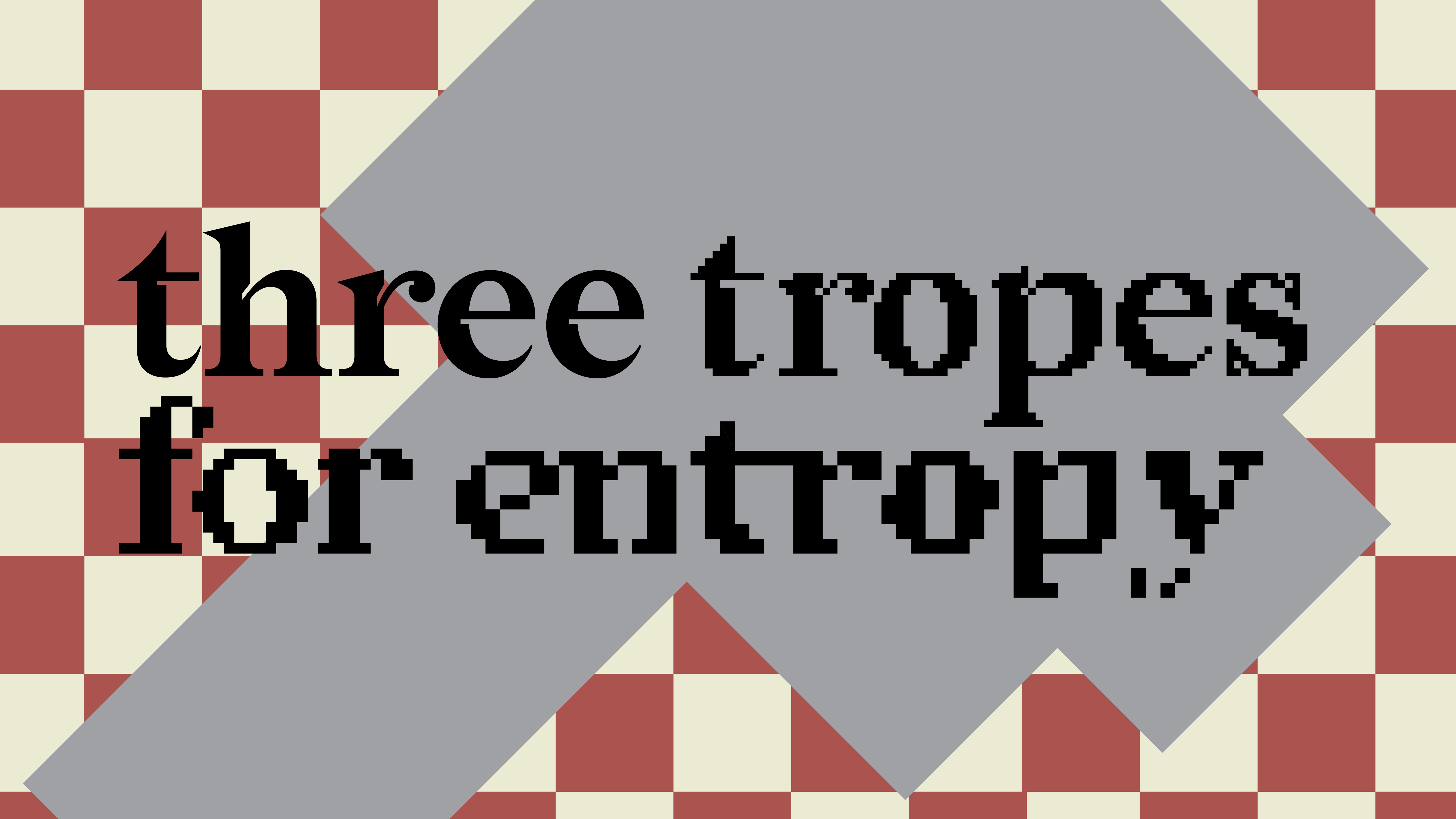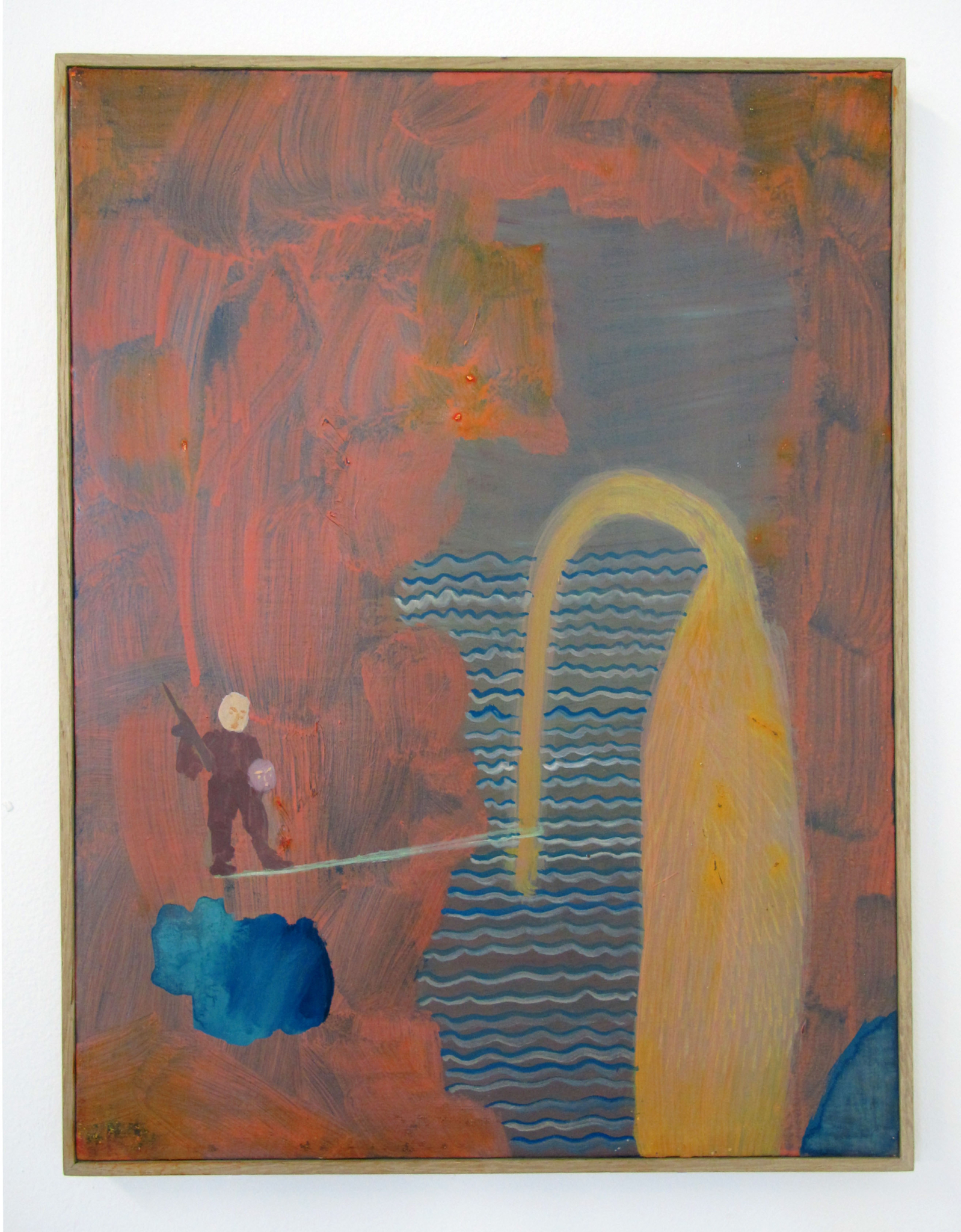
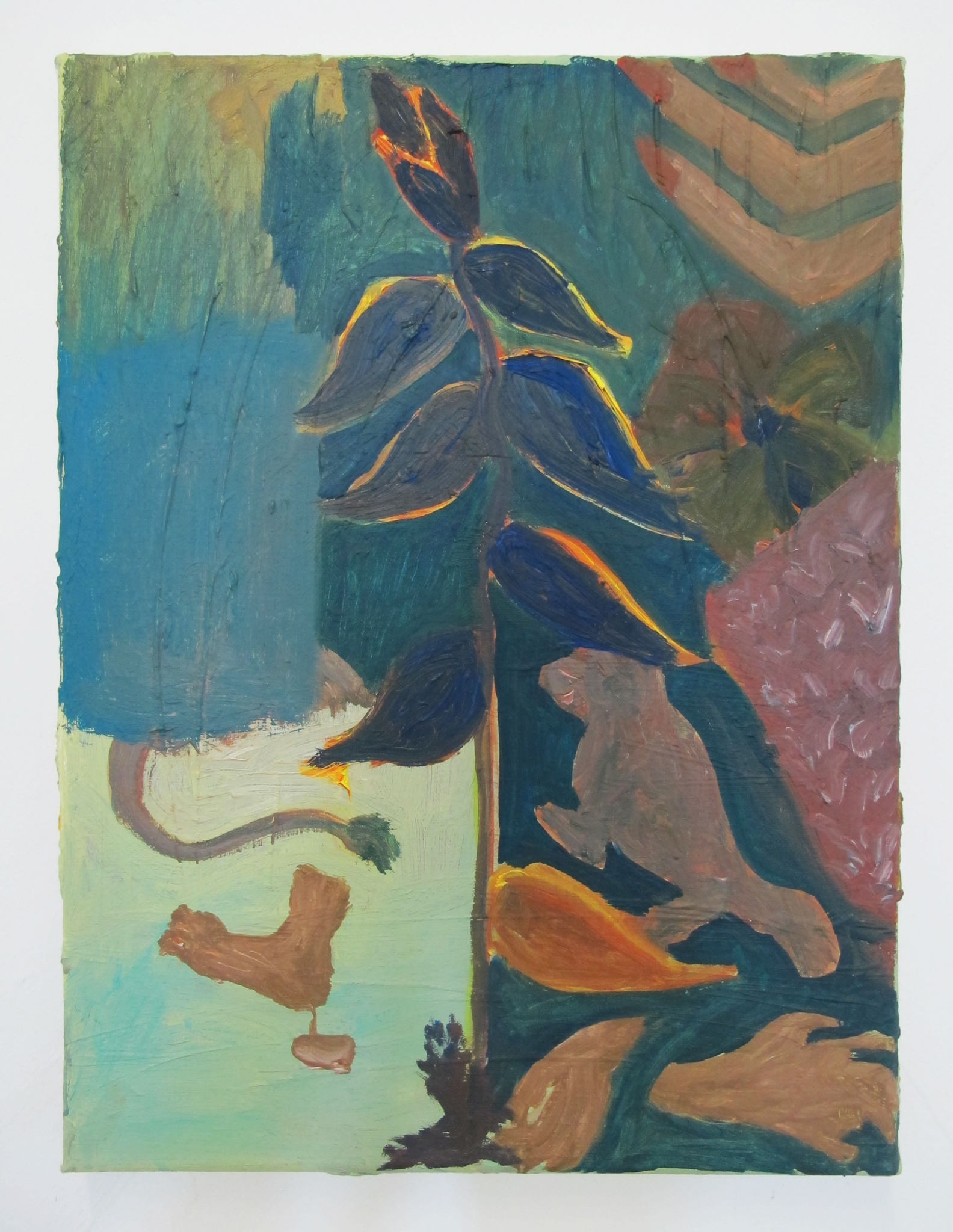
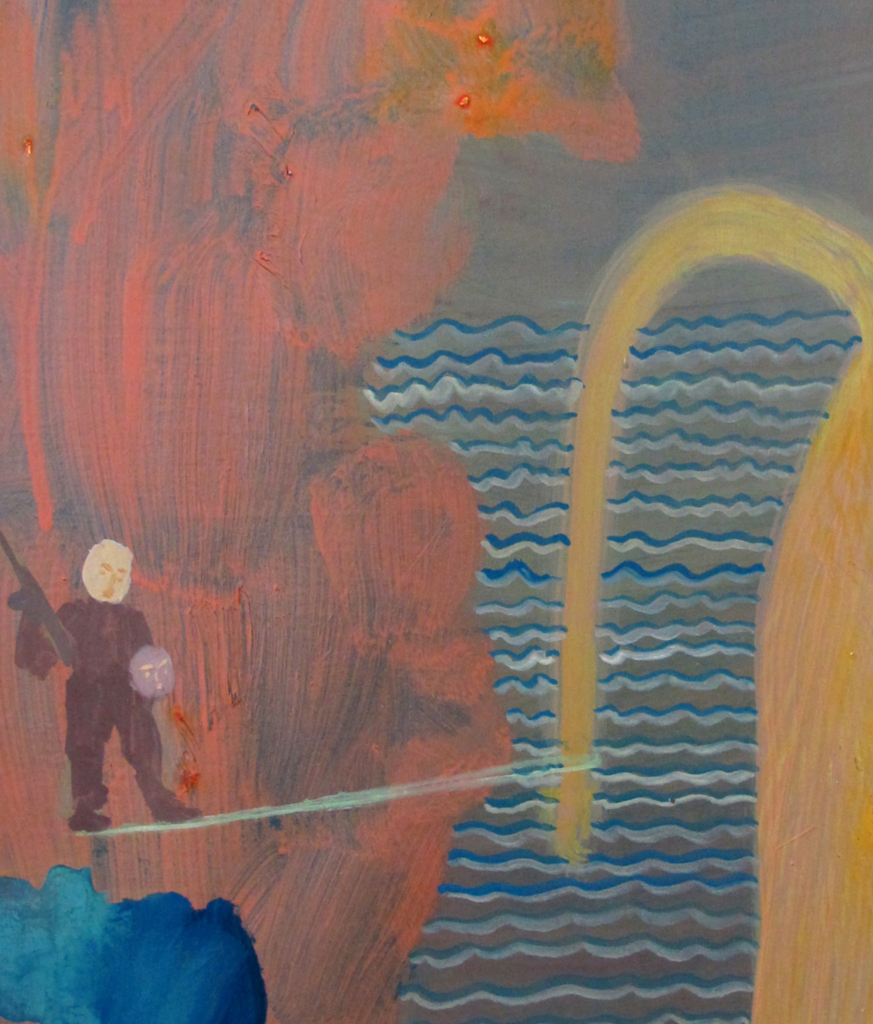
Droomland
10.09–11.12.2022
Marie Zolamian
Droomland
10.09–11.12.2022
Save the date for the finnisage: Sunday 11.12.22
This autumn, we proudly present Marie Zolamian’s (°1975, LB) new monumental work during Droomland*, her solo exhibition at Jester. Her work finds itself at the distinction between colourful, familiar scenes, art historical references, and a déjà vu-like dreamy world where mysterious silhouettes and creatures appear. Like a fictitious ethnologist she keeps an observational images diary, for which she draws inspiration from daydreaming, testimonies, local history or cultural customs linked to the place from which she works.
In preparation for her solo presentation at Jester, the artist briefly stayed at the Emile Van Dorenmuseum, where she soaked up the stories that enfolded the Genk tradition of landscape painting. Here, ‘Bezoekt droomland Genk’ (translated as ‘Visit dreamland Genk’), a slogan from an old tourist advertisement, caught her attention. Buried in the city’s recent mining and industrial past, one would almost forget that at the end of the 19th and the beginning of the 20th century Genk was known as a ‘station d’artistes’, where the vast nature and rustic life appealed to the imagination and attracted visitors, especially artists, from home and abroad. To this day, this post-industrial region boasts enormous biodiversity in and around its various nature reserves. For Zolamian, nature is imaginary. Her pictorial semblance celebrates diversity and crossing, which for her are a pretext for painting.
For Droomland, the artist takes over Jester’s exhibition space. While in the studio smaller canvases are a familiar starting point, Zolamian will work in situ on a monumental creation in the weeks before the opening. Layer after layer, a landscape will be shaped. Playing with camouflage, approach and resistance, this large-scale work offer – despite its scale – an intimate glimpse into the mysterious universe expressed in Zolamian’s oeuvre.
*Droomland means dreamland
Admonestation, 2022.
Oil on canvas on panel, 41 x 31 cm.
Image by courtesy of Marie Zolamian
PRACTICAL INFORMATION:
On Saturday, the 10th of September, the opening takes place between 3 and 7 p.m. You can find our presentation space on the 1st floor of the C-mine energy building. Droomland is on view, every day except on Mondays, from 10 a.m. till 5 p.m. The show runs until the 11th of December.
Related Projects
Art Trip Marie Zolamian
28.10.2022


Riding High in the Reading Saddle
21.05–07.08.2022
Alexis Gautier
Riding High in the Reading Saddle
21.05–07.08.2022
Guided tour: Sunday,
07.08, 4 p.m.
Alexis Gautier’s work explores the relationships at play in cultural transactions, collaborations and the creation of narratives. Often made with other individuals, his work creates a space for exchanges and appropriation, weaving encounters, discoveries and misunderstandings. Gautier documents his research and interventions through textiles, sculptures, videos, narrations and drawings. FLACC/CIAP invites the artist to continue his research during his residency in Genk, which will culminate in a solo exhibition in May 2022.
Guided tour: Sunday, 07.08, 4 p.m.
During the finissage of Riding High in the Reading Saddle, join us for the guided tour of the exhibition.Jester’s artistic director Orlando Maaike Gouwenberg will be your guide through the work of Alexis Gautier and the unique indoor and outdoor spaces at the C-mine site. The meeting point is the visitor’s desk at C-mine.
Alexis Gautier (FR) is currently a resident at WIELS (Brussels) and an affiliated researcher in the arts at the Royal Academy of Fine Arts in Antwerp. He graduated from the Städelschule in Frankfurt am Main (DE) and from the Royal Academy of Fine Arts of Antwerp (BE). He had solo exhibitions at Museum M Leuven (2021), ISLAND (Brussels, 2020), Basis (Frankfurt Am Main, 2019), Blue Mountain School (London, 2018) and BOZAR (Brussels, 2017). He was awarded the Günther-Peill Stiftung (Düren, DE) and is supported by the Fondation des Artistes (Paris, FR) and by the Flemish Community.
.







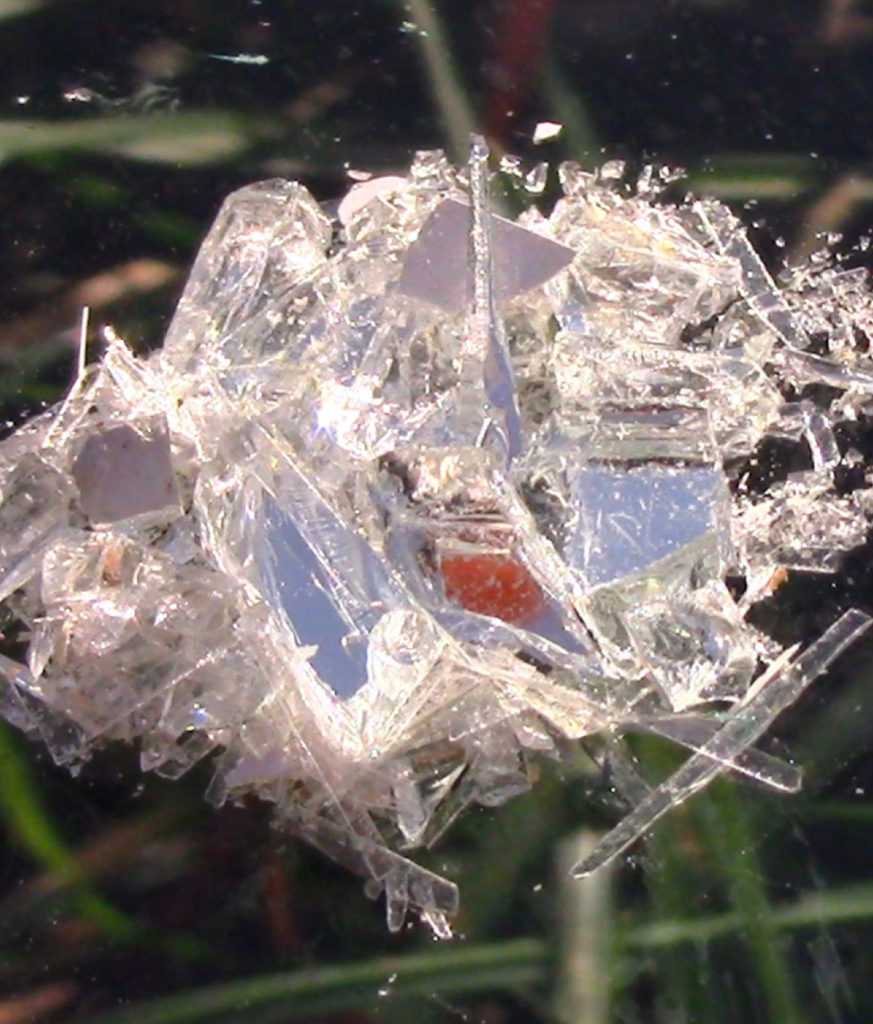
Three Tropes for Entropy
05.02–01.05.2022
Lichen Curatorial Prize
Three Tropes for Entropy
05.02–01.05.2022
Until the 1st of May, you can discover the works of the 2nd trope in the C-mine compressors hall.
With works by mountaincutters (FR), Angyvir Padilla (VZ) and Daniel Steegmann Mangrané (ES), Three Tropes for Entropy delves into three distinctive artistic practices, presenting their singular approaches towards notions of flux, energy, and transformation.
Laila Melchior and Koi Persyn — laureates of the second edition of the Lichen Curatorial Prize — present a transformative exhibition connecting three artistic practices and methodologies to the unique site of the former Winterslag coal mine. Having hosted an industrial complex of coal exploitation for approximately a century, this former mine site embodies the capacity to generate and process energy not only through its history but also in its recent transformation into a creative hub.

Daniel Steegmann Mangrané, Phasmides
16mm film transferred to HD video, color, mute,
22’41”, 2012, Courtesy Mendes Wood DM, São Paulo and Esther Schipper, Berlin
‘Trope’ and ‘entropy’ share the same ancient Greek root in the word τροπή, evoking the ideas of turn and transmutation. Tropes are literary motifs that use figurative forms of language to increase the tangibility of meaning, stimulating associative perceptions. Entropy is a term that has gained momentum in current times. A scientific concept that stems from thermodynamics, it indicates a transmission process within a closed circuit. Drawing from this specific usage to a more general one, it has been widely used to exemplify the irreversibility of time, of processes that have a clear start but no defined end and that can become quite invisible, as much as they are omnipresent.
In parallel with and inspired by such a mixture of possible approaches to the phenomenon of transformation, the exhibition itself undergoes a change over its course. Three Tropes for Entropy opens with clusters of works highlighting each participating practice and gradually evolves towards an intermingled diffusion of particles. These transformations will be marked by three activated moments or chapters – identified by the curatorial duo as exhibition’s ‘tropes’:
risquer sa mutation :
programme d’une pensée sans domaine
05.02 – 03.04.2022
Ella es su espejo incendiado, su espera en hogueras frías.
05.03 – 01.05.2022
Eu era gases puro, ar, espaço vazio, tempo.
01.05.2022 – …
These gradual changes allow for interactions between the works themselves and the space, modulating intensities to render visible the mutability that circulates inside the engines of practices.
Film Programme
Three films presented during the opening weekend of Three Tropes for Entropy can now be watched below. The screening was part of risquer sa mutation : programme d’une pensée sans domaine, the exhibition’s first trope.
-
- Daniel Steegmann Mangrané, Phasmides, 2012; 22’41”, 16 mm transferred to HD, colour, mute, courtesy of Mendes Wood DM, São Paulo and Esther Schipper, Berlin
- Angyvir Padilla, 21 años de mala suerte (21 years of bad luck), 2014; 04’04“, colour, sound, courtesy of the artist
- mountaincutters, Supplique pour le beau temps, 16 mm transferred to HD, colour, mute, 2’08”, 2021, production by fondation d’entreprise Hermès
The artists
mountaincutters (FR, °1990) is a hybrid identity, living and working in Brussels. Their duo-practice consists mainly of site-specific sculptures that reconfigure the space where they are exhibited. Through poetic texts and analogue photographs, the duo often finds historical and/or material leads that form the basis of their sculptural installations. These constellations of glass, ceramic, copper and metal objects are in constant flux, forming a closed circuit between the different entities. The in-situ works balance on the threshold of inactive and dynamic, present and invisible, rough and refined. Like an echo of this confused identity, the installation adds an aesthetic uncertainty, favouring transitory situations and unfinished forms for seemingly fortuitous compositions. mountaincutters unifies phenomena that are considered incompatible into one coherent volume, therefore pushing the boundaries of the sculptural into conflict.
Angyvir Padilla (VZ, °1987) lives and works in Brussels. In her practice, she invites the viewer to look closer at the places we inhabit by examining how we embody memory. Padilla proposes that the traces of our past seep into a persistent present. Her immersive installations distil the concept of ‘home’ as an intimate, secluded place and relate this notion to people and nature. Padilla’s practice explores the discrepancies and intervals between identity, material and space. Her work turns around the sense of otherness one encounters once presence enters into a dialogue. Angyvir Padilla often works presenting objects and processing materials in relation to the spatial environment in order to connect emotionally with the viewer.
Daniel Steegmann Mangrané (ES, °1977) lives and works in Rio de Janeiro. His research is composed of subtle yet crude experiments that question the relationship between language and the world. Although primarily conceptual, his installations engage with the spectator’s imagination and exhibit a strong concern with the existence of everything we see, but especially on everything that we do not see. Mangrané’s work often traces the boundary where nature meets artifice. Lines, circles and rhombuses are drawn, cut and projected onto leaves; the delicate symmetry of branches is split in two. These precise interventions hold a powerful force of attraction: a moment of uncertainty between what is contrived and what is natural. In each of Steegmann Mangrané’s intricate compositions, we get to experience that, far from being distinct, the organic and the geometric, the vital and the abstract, define each other.
The curators
Laila Melchior is an independent curator and researcher investigating the fields of contemporary art and audiovisual aesthetics. She holds a master’s degree in Communication and Culture from UFRJ (BR) and a postgraduate degree in Curatorial Studies from The Royal Academy of Fine Arts (KASK). Laila Melchior works on projects related to arts, film and theory, looking to incorporate perspectives from the Global South into her projects. As a curator, she collaborates with art institutions. Some of her recent projects are the exhibitions Trojan Horse Behind Glass; Time, Times. Half a Time; and The Ghost Library. She is one of the founders and part of the curatorial board of Aventuras do Pensamento, a series of encounters between a children-composed audience and some of the greatest contemporary Brazilian thinkers, scientists and artists that since 2016 discusses pressing issues in the political, innovative and creative horizon of the country. Laila Melchior has also designed the Young Curators Programme, a project which she coordinates to promote a greater engagement of emerging curators in the frame of Belgian participation in the Venice Biennale. Formerly a lecturer at the undergraduate course in Cinema and Digital Media at IESB (Brasilia – BR), she has also published and presented academic works.
Koi Persyn is a Brussels-based independent curator and visual artist. He obtained a master’s in Fine Arts at The Royal Academy of Fine Arts (KASK) after which he completed a postgraduate in Curatorial Studies, also at KASK. During his studies, Koi Persyn founded and co-curated STOCK, a three-year-running residency programme in Het Paviljoen, Ghent. His artistic and curatorial trajectory encompasses notions of authorship and collectivity, employing experimentation with exhibition formats in unconventional locations. His curatorial projects focus on process-based, experimental, and interdisciplinary practices through open-air, collaborative, site-specific exhibitions and residency programmes. Koi Persyn participated in the exchange programme with BIDAI college of arts in Kanazawa (JP) and worked in the framework of the Young Curators Program as a mediator for the Belgian Pavilion at the 58th edition of the Venice Biennale. Koi Persyn co-curated Publiek Park, an open-air group exhibition in the Citadelpark of Ghent, as part of his activities in the frame of the Young Friends of S.M.A.K. Currently, Persyn develops the annual programme of Komplot in Brussels as a guest curator.
Lichen is a prize for emerging curators, established by CIAP platform for contemporary art and the department of Curatorial Studies at KASK School of Arts to foster and support curatorial experimentation in Belgium. With the support of the Flemish Community, the City of Genk, and the CIAP members.
Related Projects
Petrichor
13.09–08.11.2020

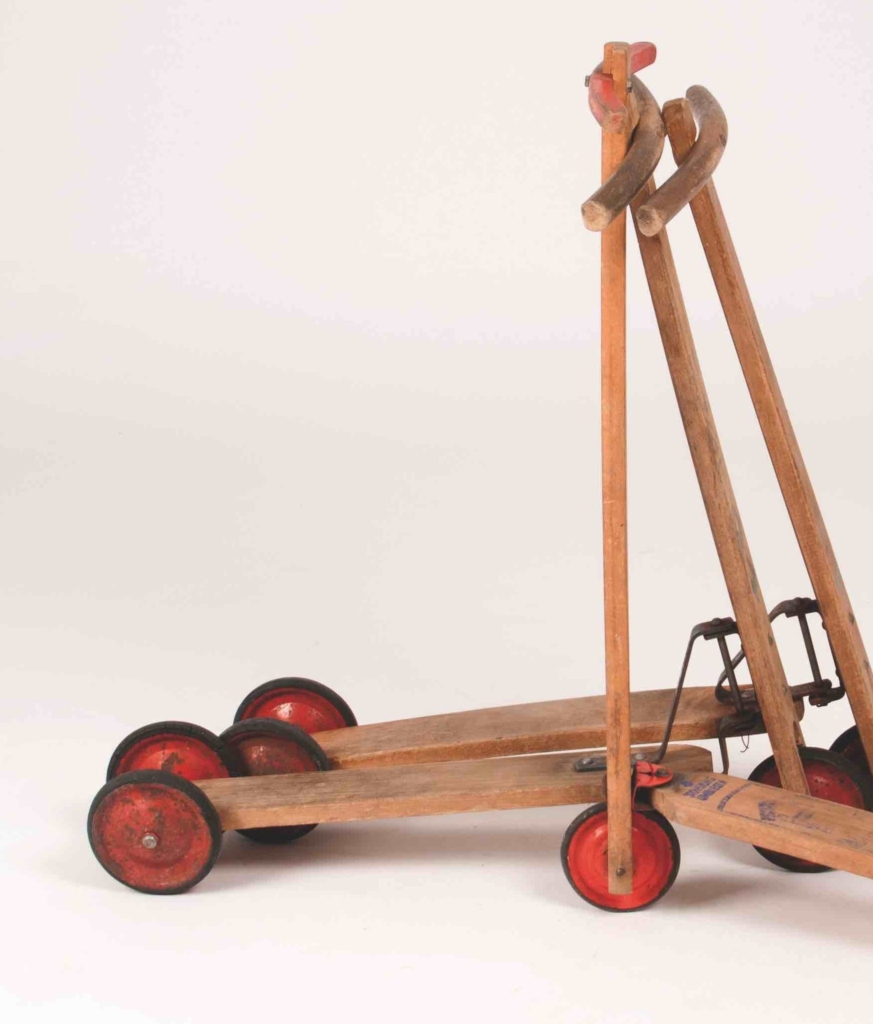
Mine de rien
23.10.2021–16.01.2022
Marianne Berenhaut
Mine de rien
23.10.2021–16.01.2022
Marianne Berenhaut’s body of work, spanning over five decades and still expanding, eludes any attempt at a summary. It cannot ever be explained or fully grasped; it needs to be seen, experienced and felt to the bone. The exhibition at CIAP and C-mine presents a subjective choice from this generous oeuvre. Sculptures, installations, and collages made of objects found in the artist’s immediate surroundings are accompanied by a selection of archival materials, including previously unseen footage and newly commissioned documentation. Placed side by side, the works created years apart come into dialogue and reveal their lasting relevance. The expression ‘mine de rien’, borrowed for the title of this exhibition, describes someone acting casually, ‘as if nothing was at hand’, much like the works of Marianne. Hidden behind the facade of daily objects are memories and stories we all can relate to, but also experiences that remain deeply individual and, on some level, inaccessible.
The very present, symbolically charged architecture of the former mine of Winterslag lends itself as a perfect setting to highlight specific facets of Marianne’s practice. Now a creative site, it used to be the heart of the extractive industry and a gravitational core of the cité, attracting newcomers to Genk. What better context to reflect on the subjects of care, labour, trauma, and healing, which surface, in a more or less direct way, throughout this body of work.
PRACTICAL
The tickets to this exhibition can be now purchased via C-mine’s website.
FOLLOW THIS LINK to reserve your ticket.
GUIDED TOURS
CIAP organizes three tours guided by the curatorial team. The curators reveal some anecdotes about the works and share their own experiences with Marianne Berenhaut’s oeuvre. Participating in a guided tour is included in your expo ticket. Register via the link below, but do not forget to also purchase a ticket for the exhibition on the same date. The number of places is limited.
Saturday 06.11.21, 2:00 to 3:00 p.m. (English)- Saturday 11.12.21, 2:00 to 3:00 p.m.(Dutch)
- Saturday 08.01.22, 2:00 to 3:00 p.m.(Dutch)
This exhibition is a collaboration between CIAP and C-mine. With the kind support of the Flemish Community, the city of Genk, and CIAP members.
Bio
Marianne Berenhaut (1934, BE) lives and works between Brussels and London. She studied fine arts at the Académie du Midi and Atelier de Moeschal (1960-1964). Her works were presented in various solo exhibitions, at La Maison des Femmes (Brussels), Musée Juif de Belgique (Brussels), MAC’s (Grand Hornu), Isy Brachot Gallery (Brussels), Nadja Vilenne Gallery (Liège), and Island (Brussels). She has been part of several group exhibitions, amongst others at Maison Grégoire (Brussels), Gladstone Gallery (Brussels), Bureau des réalités (Brussels), and Carl Freedman Gallery (Margate, UK). She is represented by Dvir Gallery (Brussels/ Tel Aviv).



